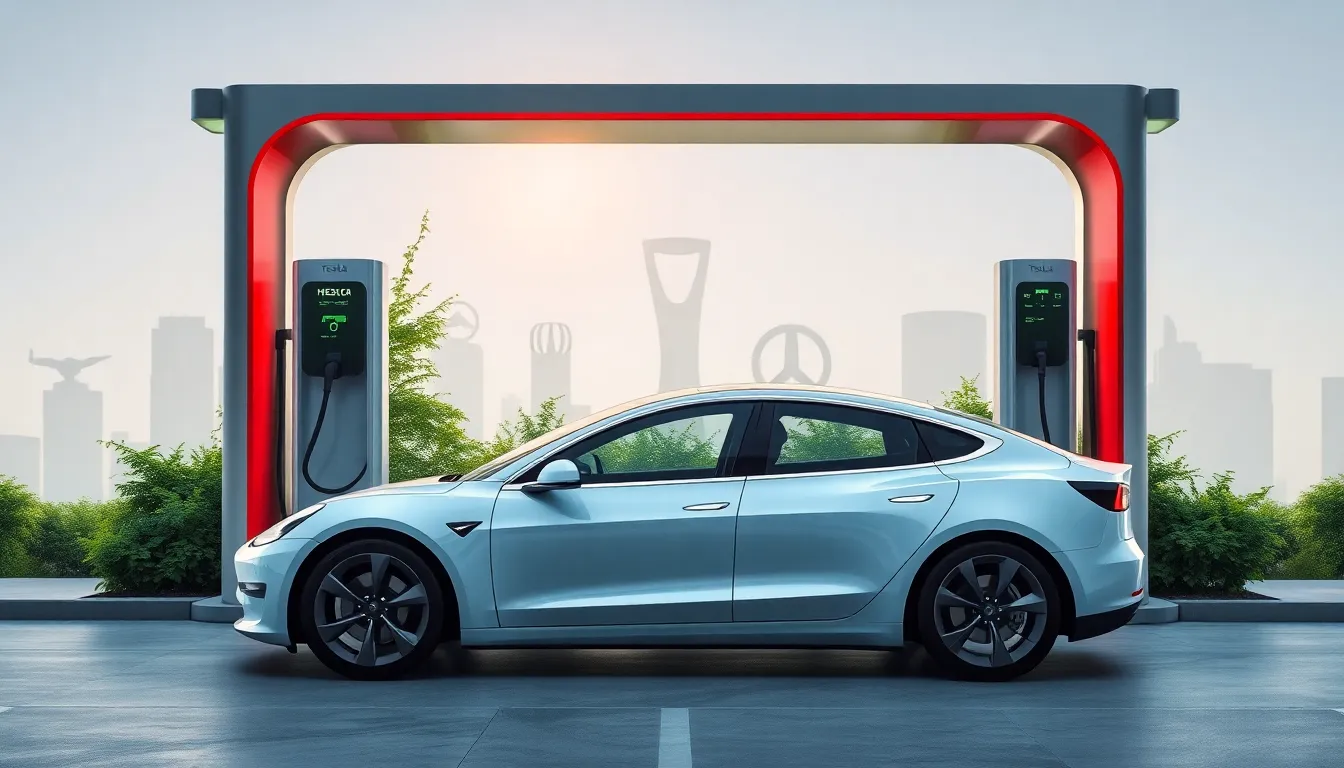Electric vehicles are no longer just a futuristic dream; they’re zooming into reality faster than you can say “range anxiety.” With advancements popping up like popcorn at a movie theater, the EV landscape is evolving at breakneck speed. From mind-blowing battery technology to sleek designs that could make even a gas-guzzler blush, there’s never been a better time to plug into the electric revolution.
Table of Contents
ToggleOverview Of Electric Vehicle Developments
Electric vehicles (EVs) experience continuous improvements across various aspects. Battery technology stands at the forefront, with energy densities improving significantly. Recent advancements in solid-state batteries show potential for longer ranges and faster charging times.
Design plays a crucial role in the development of EVs. Manufacturers focus on creating stylish, modern vehicles that attract a broader audience. Aerodynamic shapes and innovative materials contribute to both aesthetics and efficiency.
Infrastructure continues to expand, allowing for increased accessibility to charging stations. Fast-charging networks grow, enabling drivers to charge their vehicles rapidly on long journeys. Governments promote incentives for building charging infrastructure, enhancing convenience.
Range anxiety decreases as technological advancements extend driving ranges. Many new models now exceed 300 miles on a single charge, reassuring potential buyers. Fleet vehicles also adopt electric options, showcasing their reliability and efficiency in commercial applications.
Consumer interest increases as awareness of environmental impact rises. Many buyers consider the reduction of carbon footprints a priority when selecting vehicles. This growing demand encourages manufacturers to invest more in EV technology, propelling further developments.
Regulatory changes impact the market as governments set ambitious emission targets. These regulations drive manufacturers to innovate and diversify their electric offerings. Collaborations among automakers, technology companies, and governments foster a dynamic development environment for the EV sector.
As a result, electric vehicles emerge as a viable and attractive option for consumers and businesses alike. The ongoing evolution in battery technology, design, infrastructure, and regulatory support creates a promising future for electric mobility.
Key Players In The Electric Vehicle Market
The electric vehicle market features a blend of established automakers and innovative startups, each contributing to the industry’s growth and evolution.
Major Automakers
Automakers like Tesla, General Motors, and Ford lead the electric vehicle landscape. Tesla pioneers EV technology and infrastructure, setting benchmarks for performance and range. General Motors emphasizes a diverse electric lineup with the Chevrolet Bolt and plans for an all-electric future by 2035. Ford follows closely, introducing the Mustang Mach-E and the electric F-150 Lightning, which cater to a broad customer base. Each company regularly invests in research and development to enhance battery efficiency and expand accessibility.
Startups And Innovators
Startups and innovators like Rivian and Lucid Motors disrupt traditional markets with fresh ideas. Rivian focuses on electric trucks and SUVs, targeting adventure enthusiasts. Lucid Motors captivates luxury consumers with the Lucid Air, showcasing advanced battery technology and high-performance specs. Companies like NIO and Xpeng from China also gain attention, offering competitive features and government-backed initiatives in the Asian market. Each of these startups contributes to an ecosystem that fuels competition and sparks innovation within the broader electric vehicle sphere.
Technological Advancements
Electric vehicles continually evolve through significant technological improvements. Two areas garnering attention include battery technology and charging infrastructure.
Battery Technology Enhancements
Innovations in battery technology profoundly influence electric vehicle performance. Solid-state batteries, for example, provide increased energy density, promising longer driving ranges exceeding 400 miles. Enhanced charging rates reduce downtime, with some systems achieving full charges in under 30 minutes. Additionally, companies are exploring cost-effective materials, aiming to lower production expenses and boost affordability for consumers. As manufacturers refine battery recycling processes, environmental impacts decrease, supporting a more sustainable lifecycle for electric vehicles. This relentless focus on advancements positions battery technology as a fundamental driver of growth in the EV market.
Charging Infrastructure Improvements
Expanding charging infrastructure plays a critical role in making electric vehicle ownership more practical. Fast-charging networks have multiplied, allowing easy access across urban areas and highways, reducing obstacles for long-distance travel. Specific regions show impressive advancements in charging station availability, with California leading the way with over 80,000 public connectors. Partnerships among automakers, utility companies, and governments foster collaboration, helping accelerate the installation of charging points. Efforts to enhance home charging solutions also contribute to convenience, with smart charging systems optimizing energy usage. These developments create a robust foundation for the widespread adoption of electric vehicles.
Environmental Impact Of Electric Vehicles
Electric vehicles (EVs) offer significant environmental benefits, specifically in reducing pollution and promoting sustainability. Their transition from internal combustion engines greatly contributes to cleaner air.
Carbon Footprint Reduction
The shift to EVs leads to notable reductions in carbon emissions. Statistics show that EVs can lower greenhouse gas emissions by 50% compared to traditional vehicles. This reduction relies on the energy sources used for electricity generation. When powered by renewable energy, emissions drop even further. States like California, which prioritize renewable energy, exemplify this trend. As more drivers adopt EVs, the overall carbon footprint decreases, improving public health and mitigating climate change impacts.
Sustainable Manufacturing Practices
Manufacturers are increasingly focusing on sustainable production methods for EVs. Innovations in resource sourcing minimize environmental damage. Companies often utilize recycled materials in battery manufacturing to reduce waste. Many automakers are investing in sustainable practices throughout their supply chains. For instance, Tesla and General Motors emphasize responsible sourcing of materials like lithium and cobalt. These practices not only lower carbon footprints but also promote ethical labor standards. Green manufacturing processes further enhance the overall sustainability of electric vehicles.
Future Trends In Electric Vehicle Developments
Manufacturers are set to leverage advancements in battery technology, focusing on solid-state batteries that promise over 400 miles of range. Charging times for these batteries may drop significantly, allowing full charges in under 30 minutes. Efforts to reduce production costs are underway, including the exploration of cost-effective materials and improved recycling processes.
Innovative designs reflect the modern aesthetic demanded by consumers. Stylistic improvements not only aim to attract buyers but also enhance aerodynamics and energy efficiency, further optimizing driving experiences. Charging infrastructure continues to expand rapidly, with partnerships among automakers, utility companies, and governments driving the installation of new charging points.
Rising consumer awareness about environmental impacts strengthens the push toward EV investment. Regulatory frameworks are facilitating this transition through stringent emission targets, thereby encouraging collaboration across sectors. Major players like Tesla, General Motors, and Ford lead the charge, each introducing a variety of electric models aimed at diverse consumer preferences.
Startups such as Rivian and Lucid Motors introduce fresh perspectives, targeting niche markets while showcasing cutting-edge technology. Companies like NIO and Xpeng are also gaining prominence, contributing to a dynamic and competitive landscape that fuels continuous innovation.
Environmental benefits associated with electric vehicles are indisputable. EVs reduce greenhouse gas emissions by up to 50% compared to traditional vehicles, especially when charged with renewable energy. Sustainability practices are becoming crucial, with manufacturers adopting eco-friendly approaches, utilizing recycled materials, and ensuring ethical sourcing of lithium and cobalt.
Conclusion
Electric vehicles are transforming the automotive landscape at an unprecedented pace. With advancements in battery technology and expanding charging infrastructure, the barriers to EV adoption are steadily diminishing. Manufacturers are not only focusing on performance but also on sustainability and design, appealing to a broader audience.
As consumer awareness of environmental issues grows, the shift toward electric mobility is gaining momentum. The collaboration between automakers, technology firms, and governments is crucial in fostering innovation and enhancing the EV ecosystem. The future looks bright for electric vehicles as they continue to evolve, offering a compelling alternative that aligns with modern values and priorities.





